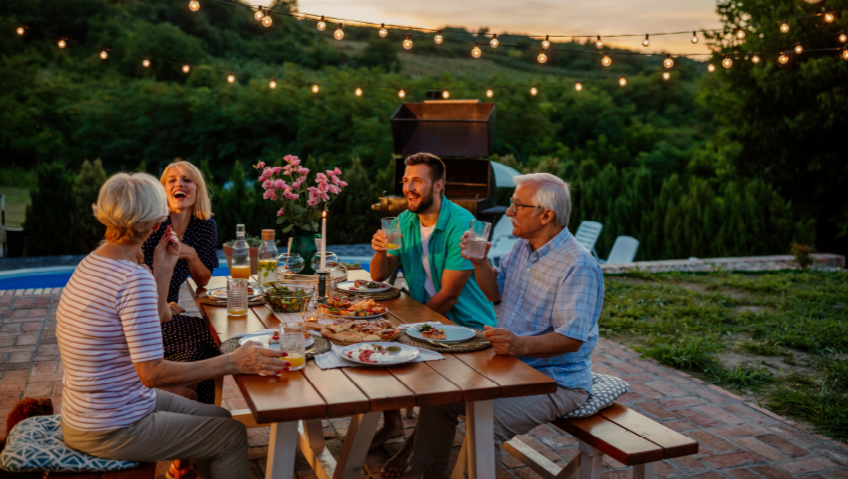A cappuccino at a table for two in St. Mark’s Square in Venice? Café au lait and a croissant at a sidewalk café in Paris? So exotic. So je ne sais quoi.
The notion of dining al fresco, while watching the world go by, was relatively late coming to North America, with New York’s Hotel St. Moritz being one of the first to advertise a continental café with outdoor seating, in the 1950s. Over the years the number of North American restaurants offering outdoor seating gradually increased, although the concept remained somewhat of a novelty. In good weather, the move was a welcome addition to the dining experience, but certainly not essential. Not until 2020, that is, when it became, almost literally, a lifeline.
In mid-March of that year, restaurants and all other non-essential business faced lockdowns due to legislation surrounding the emerging pandemic. And when some restrictions were lifted in the summer of 2020, only restaurants that could provide outdoor seating were allowed to re-open.
The restaurant business was undoubtedly one of the hardest hit sectors, along with the entire hospitality and entertainment industries, with about 72,700 or 11 percent of U.S. restaurants forced to permanently close, according to a February 2022 Washington Post article, while over 13,000 or 10 percent of Canadian restaurants were forced out of business, according to a February 2022 Restaurants Canada Report.
These reports also agreed that an estimated eight out of ten restaurants took on debt to survive (and continue to deal with it three years later). In addition, they faced a sharp rise in food costs, supply chain issues, and labor shortages.
Making the difference
A consensus among restaurant owners showed that having a patio or investing in one—or, for those with no outdoor space, taking advantage of municipal by-laws which permitted sidewalk cafés—is what made the difference between staying open and closing. Those that had existing patios with a roof structure were able to stay open, with the help of portable heaters and blankets, even through the winters of 2021 and 2022 and the emergence of COVID’s Delta and Omicron variants.
It didn’t take long for restaurant owners without patios to recognize what was needed. According to an article in Restobiz (the official website of the Canadian Restaurant and Food Service News) which quoted data from Yelp, U.S. consumer searches for businesses offering outdoor dining increased 292 percent in year two of the pandemic, compared to pre-pandemic searches.
To accommodate public demand, around 18,000 U.S. businesses have newly listed outdoor dining spaces since the pandemic began. The total number of patio dining areas is now around 26,000 compared to fewer than 8,000 in February 2020, according to Restobiz. “In Canada, too, the demand has been high,” the article continues, “and temporary patio programs such as Toronto’s CaféTO have been expanded and extended.” They will continue to be offered in 2023 and may become permanent.
From surviving to thriving
While it is indisputable that outdoor seating, whether on a beautifully designed patio or cordoned-off section of the sidewalk (along with home delivery) was essential to the food service industry’s ability to survive the pandemic, is it still economically advisable for restaurant owners to build new patios or substantially upgrade their existing ones? The answer seems to be a resounding yes.
In 2022, The U.S.’s National Restaurant Association in its State of the Industry report said that three in four adults say they feel safer sitting at an outdoor table at a restaurant versus an indoor one if given the option, while a survey conducted by OpenTable, an international online reservation service, found that 82 percent of diners want restaurants to continue to increase their outdoor seating.
Even now, with restrictions lifted and the World Health Organization (WHO) having declared on May 5, 2023, that COVID-19 was no longer a “global emergency,” there are still people who hesitate to dine indoors.
Over and above the health concerns of eating indoors in a crowded restaurant, people are enjoying the relaxed outdoor vibe and turning to organizations such as OpenTable, which lists the 100 Best Outdoor Restaurants in both the U.S. and Canada based on consumer reviews. This type of service played an important role for the tourism industry when travel options re-opened in 2022.
With surveys and reports like these, it seems certain that the demand for patio dining will continue, whether it’s for a fine dining experience to celebrate a milestone event or more casual dining that’s kid- and even dog-friendly. What began as a survival strategy has won popularity, and provides an opportunity for operators to increase revenue and thrive once again.
According to research by the leading international restaurant and hospitality consulting firm VSAG (Vucurevich Simons Advisory Group), adding an outdoor patio can potentially increase restaurant gross profits by as much as 65 percent. The report claims that an investment of $200,000 in creating an outdoor dining space can potentially yield a gross profit of more than $500,000, with noticeable growth during the peak seasons for dining outdoors (as described in Season by Kostuch Media Ltd., Food Service and Hospitality Magazine).
“Overall, we also found that with a robust management plan in place, there is great potential for a hearty profit return on investment,” reads the report. “By looking at the space/layout options you can envision transformation of a designated area into an oasis for guests while helping to boost sales and increase your business’s outdoor dining visibility and exposure.”
Planning for success
Restaurant patios run the gamut, from the most sophisticated rooftop areas located above four-star hotels; to full-service, ground-level patios complete with retractable roofs, fire pits, and full-service bars; to screened sunporches on heritage buildings; to a few umbrella tables and chairs on a cordoned-off area of a sidewalk.
But no matter the level of complexity, they can all benefit from good design ideas such as those provided by The Fifteen Group, with offices in Vancouver and Toronto, which has helped over 1,000 restaurants achieve their profit goals.
In a pair of webinars led by the group’s President, David Hopkins, and Director of Design and Brand, Olivia Harrison, restaurant owners were offered some solid advice, as highlighted by Restobiz in a March 14, 2022 article.
“Patios are an easy way for restaurants to make more money,” Hopkins said. “We want to make sure restaurants don’t squander this opportunity because it really can add 50 percent to your bottom line. Guest experience is the number one thing that drives repeat revenue. Ultimately maintaining the quality and efficiency of your indoor dining services outdoors is crucial.”
Harrison stressed key factors, from color to consistency to spacing, that make for a profitable patio. “The most successful patios are the ones that feel like an extension of the inside of the restaurant,” she said, indicating that the décor should look intentional and be consistent with the interior.
When it comes to furniture, there needs to be a balance between comfort, style, and practicality, because it needs to be either weather-resilient or easily storable. Lighting can be crucial to creating atmosphere and she suggests using multi-level lighting—a combination of twinkle lights, bistro lights, battery or solar-powered lights, or even candles. Piped-in music, low enough so as not to disturb the neighborhood, adds to the ambiance.
Planters are another important element that makes the space attractive by adding greenery. Low shrubbery can provide privacy for diners while seated, flowers such as marigolds act as natural insect repellents, and culinary herbs such as parsley or chives, or even miniature tomatoes, can be incorporated into both the décor and the menu.
While the look and feel of the patio are certainly important, Harrison noted that it is essential to meet all zoning, food safety, and accessibility regulations, as well as posting clear signage.
With even the best designs, restaurant owners need to anticipate the weather and guest complaints, Hopkins adds. If there are no plans for a retractable roof or awning, patio tables need to be equipped with umbrellas, heaters, or blankets in winter and coolers in summer.
The final touch: food service
With all of those elements in place, Harrison and Hopkins turned their attention to the main reason for having a patio: food service, which needs to be optimized and expedited.
“Smooth service leads directly to profitability,” said Hopkins, who recommends focusing service on items that can be quickly executed on a patio, such as sandwiches and salads, or creating menu items that allow for a lot of pre-prepping so that guests aren’t kept waiting while the weather turns colder or windier than they like. He recommends shareable starters for groups and side stations installed on the patio for water and other condiments.
“Many of these suggestions would include some level of investment, but given a patio’s revenue-boosting potential, these investments are encouraged and can set your restaurant up well for the future,” he concluded.
Whether it’s in sunny California, which has the largest number of outdoor dining spaces, or chilly Calgary, Alberta, one of the first cities to introduce winter patio dining with heaters and blankets in 2021, patio dining is no longer a concept associated only with Europe. We North Americans have fully embraced it and made it our own.






